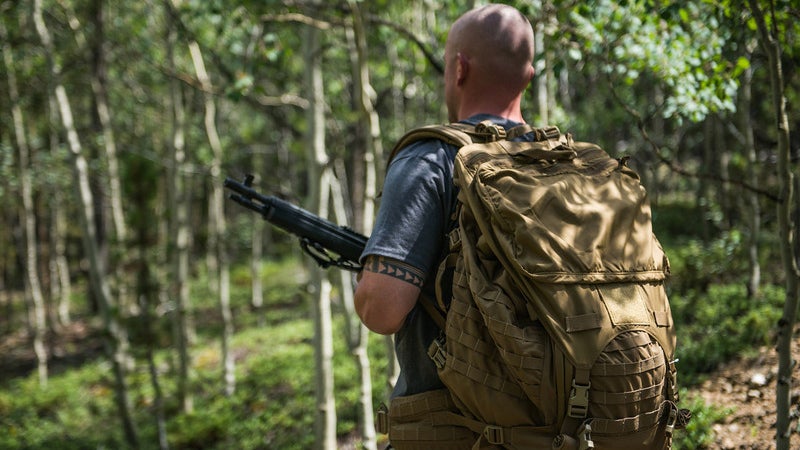If you’re asking, “What the heck is a bug out bag?” you clearly have some work to do before the four horsemen arrive. A bug out bag is basically a fully stocked survival kit that’s ready to grab in the event of a zombie attack or other emergency.
While it doesn’t sound like the Yellowstone super volcano will erupt anytime soon and the walking dead are sci-fi fantasy, a bug out bag is still an important survival tool to keep in your closet, car, or office. (If you’re really paranoid, you can have a pack for all three.) Stockpiling the right gear—and learning how to use it—can mean the difference between life and death.
I spoke with Mark Puhaly and Joel Stevens—co-owners of Forge Survival Supply and the website Survival Cache—to find out what should go in a bug out bag. The two survival gurus met as marines and have recently starred on National Geographic’s Apocalypse 101 television show.
Both Puhaly and Stevens made it clear that your head is the most important tool you have in a dangerous situation. “All of that stuff you buy, you need to practice with it,” says Puhaly. “You need to be proficient with it.”
It’s also important to remember that everything you pack in your bug out bag will weigh you down. “One thing that we learned in the U.S. Marine Corps is that ounces equal pounds and pounds equal pain,” says Stevens. “You need to be able to travel with your gear.” With that in mind, here are six specific buying tips when you’re putting together your first bug out bag.
Backpack
“Look for a well made backpack,” says Stevens. “Survival is something you want to invest in.” Military packs are a good place to start, but a bag from an outdoor store is also a viable option. In addition to being durable, get a pack that will accommodate all the gear you plan to load in it. It should have at least 2,000 cubic inches of packable space, according to Stevens. Make sure it’s still comfortable when stuffed full.
Shelter
“Your first consideration is, ‘How many people are you going to need to shelter?'” says Stevens. If you plan to shelter your family, your tent or bivvy should be big enough to accommodate the group. If you’re flying solo, look for a one-person tent. Take the climate of your surrondings into account. It’s nice to be able to go light with a Gore-Tex bivvy, but that isn’t an option if you live in northern Minnesota where a four-season tent will keep you much more comfortable.
Water Filter / Bottle
“Water purification is a vital component of your bug out bag,” says Stevens. “You can go a couple days without food, but not many without water, and bad water is almost worse than no water.” When researching what kind of purification system to use, Stevens suggests looking at products such as the Katadyn MyBottle that work as both a water bottle and a filter.
Food
Puhaly suggests packing enough high-calorie, lightweight food in your bug out bag to last 72 hours. This means about 1,500 to 3,000 calories per day for each person. And keep in mind how you’re going to feed yourself after those calories run out. Stevens recommends buying a guide to the edible plants that grow around your home. Fishing line and a slingshot are also key items when it comes to food gathering. “You can do some really good small game hunting with a slingshot and its unlimited ammo,” says Stevens.
Communication
If you plan to use a cell phone, make sure you bring a solar charger. Hand-crank radios are another useful way to tune into the world around you—you can pick one up for less then $80, Puhaly says. A signal mirror, solar blanket, or bright clothing can also be used to communicate your location.
Fire
Learning how to make fire in inclement weather is a key survival skill. While a magnesium flint or magnifying glass are great reusable ways to get a fire started, it doesn’t hurt to throw a lighter in your bug out bag, too. Puhaly also suggests packing fire starters such as cotton balls soaked in Vaseline.
Safety
Always maintain situational awareness, Puhaly says. “You should have some means to defend yourself if something bad should happen,” Puhaly says. “This could be either a weapon or a trap or an early-warning system.”

